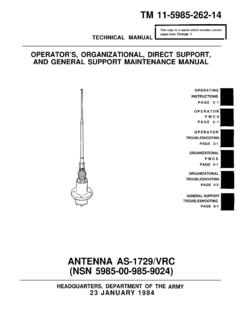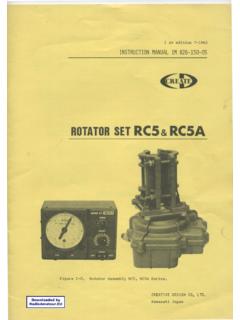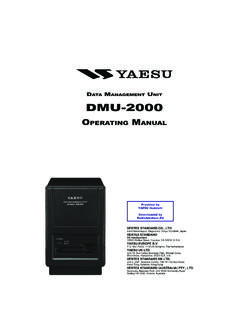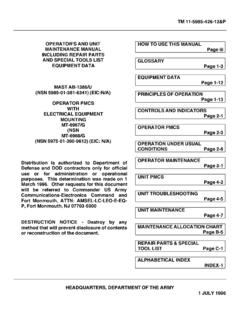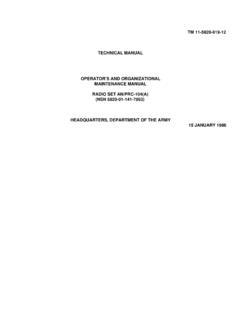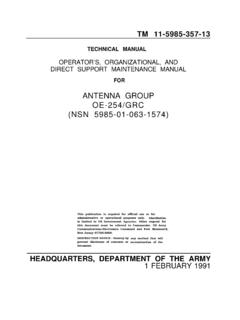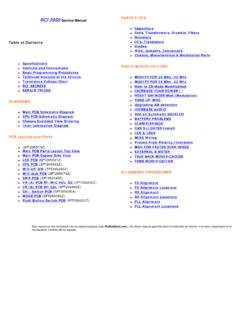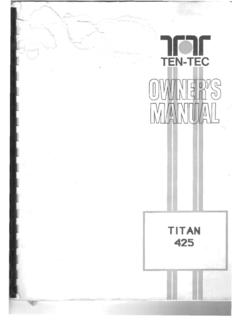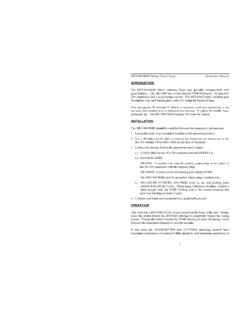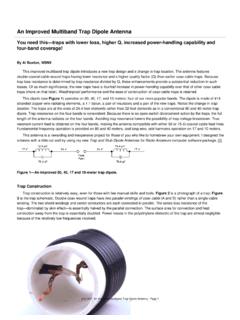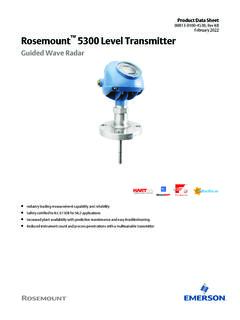Transcription of MFJ-949E Versa Tuner II Instruction Manual
1 MFJ-949E Versa Tuner II 1 MFJ-949E Versa Tuner II Instruction Manual General Information The MFJ-949E is a 300 watt RF output power antenna Tuner that will match any transmitter or transceiver to virtually any antenna. Peak or average forward and reflected power and SWR can be read on the illuminated cross-needle meter. The MFJ-949E uses a "T" matching network and covers all bands between 160 and 10 meters. This network will tune dipoles, inverted-vees, verticals, mobile whips, beams, random wires, and many other antennas. The MFJ-949E has rear panel connectors for coaxial , single wire or two wire feedlines. A built-in 4:1 balun allows the use of balanced open wire, twinlead, or twin-axial feedlines.
2 An internal eight position antenna-selector switch selects a built-in 50 ohm dummy load, two separate coaxial line outputs, or a single wire line-balanced line output. All of these functions can be selected in tuned (with Tuner 's "T" network in line) or bypassed (no tuning circuit) configurations. Peak Reading SWR/Wattmeter The illuminated cross-needle meter measures the peak or average FORWARD power , REFLECTED power , and SWR. The wattmeter is active in all the ANTENNA SELECTOR positions. To use the wattmeter without the tuning circuit select one of the ANTENNA SELECTOR positions under BYPASS. The meter's full scale forward and reflected power range is controlled by the left METER switch that selects 300W or 30W.
3 If your transmitter runs more than 30 watts of output power , set this switch to 300W (in position). If your transmitter has less than 30 watts of output, set this switch to the 30W switch position (out). Peak envelope power (PEP) is measured when the PEAK or AVERAGE METER push button (right-hand side) in placed in the PEAK (in) position. Peak power and average power values are equal with steady unmodulated carriers, FSK, or FM. The PEP power is twice the average power with SSB two tone test modulation, and may be any amount larger than the average power with SSB voice signals. Forward power is displayed on the left-hand FORWARD meter scale. This scale is calibrated from 0 to 300 watts and is read directly in the 300 watt position.
4 Each picket (scale mark) represents 25 watts between 300 and 100 watts, 10 watts between 100 and 10 watts, and has a single 5 watt picket below 10. MFJ-949E Versa Tuner II 2 In the 30W position the forward power scale must be divided by 10. Each picket represents 1/2 watt below 1 watt, 1 watt from 1 to 10 watts, and watts from 10 to 30 watts. The reflected power is read on the right-hand REFLECTED meter scale. This scale indicates 60 watts full scale when the 300W power sensitivity is selected, and 6 watts full scale when the 30W power scale is selected. This scale has a picket every 5 watts above 10 watts and at each watt below 10 watts. This scale is also divided by 10 when using the 30W switch position.
5 When trying to measure power with a less than perfect match, the reflected power should be subtracted from the forward power readings. The most accurate peak power readings are obtained only with a sustained carrier, voice or two tone test modulation. During normal voice modulation the wattmeter will typically indicate 70% of the true peak power . The SWR is read directly from eleven red SWR curves that range from 1:1 to infinity. SWR is measured by observing the point where the forward and reflected power needles cross. The SWR is indicated by the red curve closest to the needle crossing point. No cumbersome or time consuming SWR sensitivity adjustments are required with this meter.
6 The wattmeter has an internal lamp that backlights the meter scale. The lamp circuit requires power from an external 12 Vdc source, such as the optional MFJ-1312C power supply. The rear panel jack accepts a mm coaxial plug with a positive center pin polarity. The METER LAMP ON / OFF switch turns the meter lamp off and on. Antenna Selector The ANTENNA SELECTOR switch has eight positions. From counter-clockwise to clockwise the positions are: DUMMY LOAD, BALANCED or SINGLE WIRE LINE, COAX 1, and COAX 2 with the Tuner matching circuits in line, and the reverse sequence from COAX 2 back to DUMMY LOAD with the antenna tuning circuits bypassed. Dummy Load The MFJ-949E has a built-in 50 ohm dummy load.
7 The internal load will dissipate 300 watts for 30 seconds, or 100 watts for 90 seconds. power levels above 100 watts require a three minute cooling off period between transmissions. The load will operate continuously at power levels of 25 watts or less. MFJ-949E Versa Tuner II 3 Interconnections Installation 1. Locate the Tuner in a convenient location at the operating position. Avoid placing the Tuner near microphones, speech processors, computers, TNC's or other RF sensitive devices. WARNING: If random wire or balanced feeders are connected directly to this Tuner , position the Tuner so the rear panel terminals can not be accidentally contacted by persons or conductors.
8 When transmitting with random wire or balanced lines, the rear panel feed-through insulators can operate with high RF voltages. These voltages may cause serious RF burns. These high RF voltages may also damage anything contacting or within a half inch of the terminals. 2. Install the MFJ-949E between the transmitter and antenna as shown in the diagram above. Use a 50 ohm coaxial cable to connect the transmitter or transceiver to the SO-239 (UHF female) labeled TRANSMITTER on the back of the Tuner . 3. coaxial feedlines attach to the SO-239 (UHF female) connectors labeled COAX 1 and COAX 2. 4. A random wire (longwire) antenna may be connected to the five-way binding post marked WIRE.
9 See the ANTENNA HINTS section for detailed suggestions on bringing a single wire feeder into the operating position. MFJ-949E Versa Tuner II 4 5. A balanced feedline (twin lead, open wire, or twin-axial line) may be connected to the two binding posts marked BALANCED LINE. Connect a jumper wire from the WIRE binding post, as indicated by the dotted line on the MFJ-949E , to one of the BALANCED LINE posts. This connection activates the internal 4:1 balun. NOTE: Do not connect wire and balanced antenna's to the MFJ-949E at the same time, unless you want to apply power to both antennas at the same time. If a longwire or single wire feeder is used, be sure to remove the WIRE to BALANCED LINE jumper connection.
10 Using The MFJ-949E CAUTION: Never change the ANTENNA or INDUCTOR selector switch position while transmitting! Never apply more than 300 Watts to the MFJ-949E ! In any conventional "T" network Tuner , maximum power handling and the smoothest tuning occurs when the capacitance in the network is as large as possible. In this Tuner the TRANSMITTER and ANTENNA MATCHING controls have maximum capacitance at position 0 (fully meshed), and minimum capacitance at position 10 (fully open). Be sure to use the highest possible capacitance for each band. This will provide the smoothest tuning, highest efficiency, and greatest power handling capability . The chart in the tuning instructions shows typical capacitor settings that can be used for each amateur band.
